
# Rain Gauge Description: Understanding Its Function and Design
A rain gauge is a simple yet essential tool used to measure the amount of precipitation over a specific period. It plays a crucial role in meteorology, agriculture, hydrology, and even in everyday weather monitoring. Understanding its function and design can help us appreciate its importance in various fields.
## What is a Rain Gauge?
A rain gauge is an instrument designed to collect and measure the amount of liquid precipitation, primarily rain, that falls in a particular area. It provides accurate data that helps in analyzing weather patterns, predicting floods, and managing water resources.
## How Does a Rain Gauge Work?
The basic principle of a rain gauge is straightforward. It collects rainwater in a container and measures the depth of the accumulated water. The measurement is typically recorded in millimeters or inches, representing the height of the water column if it were evenly distributed over a flat surface.
### Types of Rain Gauges
There are several types of rain gauges, each with its unique design and method of measurement:
– Standard Rain Gauge: This is the most common type, consisting of a funnel that directs rainwater into a measuring cylinder. The cylinder is marked with measurements to indicate the amount of precipitation.
– Tipping Bucket Rain Gauge: This type uses a small bucket that tips when it fills with a specific amount of water. Each tip corresponds to a known volume of precipitation, which is recorded electronically.
– Weighing Rain Gauge: This gauge measures precipitation by weighing the collected water. The weight is then converted into a depth measurement.
– Optical Rain Gauge: This advanced type uses optical sensors to detect and measure raindrops as they pass through a beam of light.
## Design Features of a Rain Gauge
The design of a rain gauge is critical to its accuracy and reliability. Key features include:
– Funnel: The funnel directs rainwater into the measuring container, ensuring that all precipitation is collected.
– Measuring Cylinder: This is where the collected water is stored and measured. It is usually marked with precise graduations for accurate readings.
– Overflow Mechanism: To handle heavy rainfall, some rain gauges include an overflow mechanism to prevent water from spilling out.
– Mounting: Rain gauges are typically mounted on a stable surface, such as a pole or a tripod, to ensure they remain level and undisturbed by wind or other environmental factors.
## Importance of Rain Gauges
Rain gauges are indispensable tools for various applications:
– Weather Forecasting: Accurate precipitation data is crucial for predicting weather patterns and issuing warnings for severe weather events.
– Agriculture: Farmers rely on rain gauge data to manage irrigation and plan planting schedules.
– Hydrology: Hydrologists use rain gauge measurements to study water cycles, manage water resources, and predict floods.
– Climate Research: Long-term precipitation data collected by rain gauges helps scientists understand climate change and its impacts.
## Conclusion
The rain gauge is a vital instrument for measuring precipitation, providing valuable data for numerous fields. Its simple yet effective design ensures accurate and reliable measurements, making it an essential tool for weather monitoring, agriculture, hydrology, and climate research. Understanding its function and design helps us appreciate the critical role it plays in our daily lives and in scientific endeavors.
Keyword: rain gauge description


